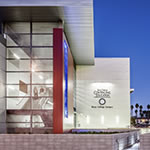When the San Diego Community College District began discussing a new building at Mesa College, the two major requirements were that it had to meet LEED Silver certification and be designed by an architecture firm that focused on sustainability. Which is why the college hired SGPA Architecture and Planning, a company that specializes in educational facilities and spends 80 percent of its time on the implementation of environmentally conscious building strategies. This time, however, those strategies were untested.
When the $12.5 million, 37,500-square-foot San Diego Continuing Education Building opened in January 2013, it received considerable praise—wasting no time in bringing home ENR California’s Best Project Award in the category of higher education and research—in part due to a unique strategy that Dave Reinker, SGPA’s principal in charge of the project, used for the first time.

A diagram shows how the unique natural ventilation system harnesses outside air with a “wind scoop” that distributes it to classrooms, each of which can control its individual temperature.
Because the continuing education building is adjacent to an athletic field but sits above it, SGPA took advantage of San Diego’s coastal breezes by combining mechanically operated windows with open-air corridors. Reinker calls the strategy the “wind scoop;” when breezes flow into the central hallway through screens located in the stairwells and clerestories, a funnel-shaped feature harnesses the wind and distributes airflow into each classroom. Each classroom has a switch that allows the users to control whether the room has natural ventilation or mechanical cooling. Reinker says that although natural ventilation isn’t a new concept, the way it is employed at Mesa College is. “The person in charge of the classroom can adjust the temperature in the room with natural ventilation,” Reinker says. “It’s interesting because the comfort range changes pretty significantly—76 or 77 degrees feels pretty comfortable when there’s movement of natural air.”
The Southern California climate has more to offer than great breezes, and the team also capitalized on the region’s near-perpetual sunshine. Large windows maximize natural light while overhangs and sunshades shelter occupants from direct sunlight. To reduce energy use, Reinker and his team installed a responsive lighting system triggered by sensors that dim electric lights during the day. The facility includes skylights on the second floor and light shelves on top of architectural elements that cast additional daylight.
SGPA currently is working on Mesa’s new cafeteria and bookstore on the main campus, which will be integrated into the existing campus style and serve as a cultural hub. “I’m hoping we can make it as energy efficient as the continuing education facility, which surpassed California’s energy-efficiency requirements by 43 percent,” Reinker says. “Our natural ventilation concept was about more than cost savings—it was about environmental stewardship.”

